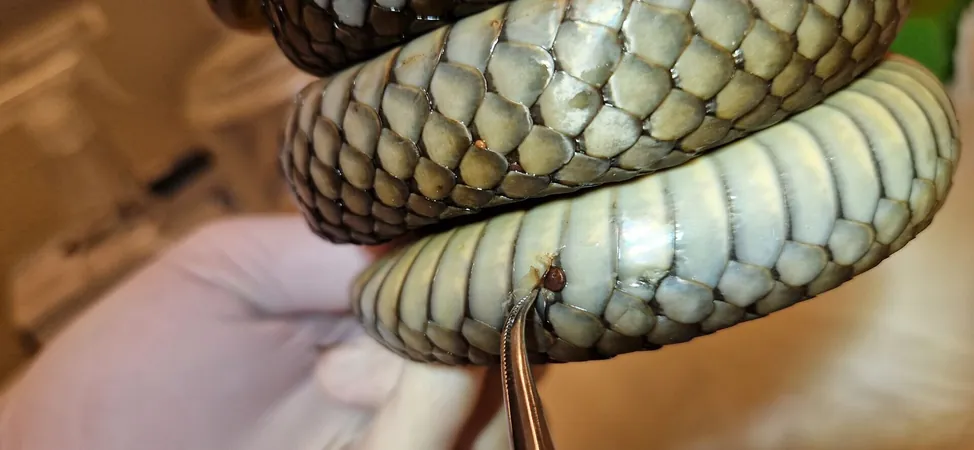
Uncovering the Mystery of a Deadly Snake Fungus in Scandinavia
2025-05-12
Author: Wei
A Deep Dive into Snake Health Risks
Researchers from the University of Agder (UiA) and Uppsala University are on a critical mission, sifting through hundreds of preserved snakes to hunt for evidence of a sinister fungal disease that threatens these reptiles' very survival.
Their focus is on Ophidiomyces ophidiicola, a fungus that poses grave risks to snake populations. This ambitious study aims to unravel its origins, identify its target species, and trace its historical impact.
Mapping the Spread of a Silent Killer
Zoologist Beate Strøm Johansen, part of the research team, explains, "We are mapping the disease to understand its effects on snake health and the pathways of its transmission." By investigating museum collections, scientists can uncover the geographical spread and historical presence of this lethal fungus.
Originally discovered in the U.S. back in 2006, the arrival of this pathogen in the U.K. in 2017 sent ripples of concern throughout Europe, highlighting an unsettling new chapter in wildlife health.
Symptoms and Severity: A Threat to Survival
The fungus manifests initially as brown, dry spots on the skin and scales, eventually invading crucial organs like the lungs and eyes. This can lead to severe breathing issues and even blindness, with the potential to decimate entire snake populations.
Johansen cautions, "Understanding the extent of this disease is essential; its impact could resonate across snake species globally."
Genetic Insights from Historic Collections
Malene Ø. Nygård, a molecular biologist and conservator at the UiA Natural History Museum, is actively isolating DNA from over 300 snakes and their shed skins gathered by Johansen and her students. This includes all snake species native to Norway, such as smooth snakes, grass snakes, and vipers.
Nygård expresses enthusiasm for their findings: "The data from living snakes and our ongoing investigations into preserved collections could yield vital insights about the disease's history and inform future conservation efforts."
Collaborative Efforts Across Countries
This research is a collaborative endeavor involving UiA, Uppsala University, and the Swedish University of Agricultural Sciences (SLU). So far, approximately 120 snakes have been examined from the Museum of Evolution in Uppsala and Oslo's Natural History Museum.
Upcoming plans include examining additional specimens at the Swedish Museum of Natural History in Stockholm and other collections in Trondheim.
A Peek into the Past: The Importance of Historical Samples
These preserved snakes, often centuries old, are kept in jars filled with alcohol or formalin, their lids tightly sealed. "We begin our investigation by inspecting them through the glass, looking for signs of infection," Johansen noted. With museum permission, they meticulously collect tissue samples for deeper analysis.
A Perilous Pathway: Human Role in Fungal Spread
While the fungus poses no direct risk to humans, it can hitch a ride on soil, equipment, or even through contaminated pet snakes, spreading to new habitats.
The Origin of the Fungus: A Mystery Unfolds
Despite ongoing studies, the origins of Ophidiomyces ophidiicola remain shrouded in mystery. It is believed to thrive in upper soil layers, yet the reasons behind its targeted assault on snakes are still unknown.
Johansen cautions about two similar, less dangerous fungi that complicate identification: "Accurate identification of this deadly fungus is essential for effective control measures."
A Race Against Time for Snakes' Future
As researchers delve deeper, they strive not only to understand this threat but also to safeguard snake species across the globe from an invisible menace.

 Brasil (PT)
Brasil (PT)
 Canada (EN)
Canada (EN)
 Chile (ES)
Chile (ES)
 Česko (CS)
Česko (CS)
 대한민국 (KO)
대한민국 (KO)
 España (ES)
España (ES)
 France (FR)
France (FR)
 Hong Kong (EN)
Hong Kong (EN)
 Italia (IT)
Italia (IT)
 日本 (JA)
日本 (JA)
 Magyarország (HU)
Magyarország (HU)
 Norge (NO)
Norge (NO)
 Polska (PL)
Polska (PL)
 Schweiz (DE)
Schweiz (DE)
 Singapore (EN)
Singapore (EN)
 Sverige (SV)
Sverige (SV)
 Suomi (FI)
Suomi (FI)
 Türkiye (TR)
Türkiye (TR)
 الإمارات العربية المتحدة (AR)
الإمارات العربية المتحدة (AR)